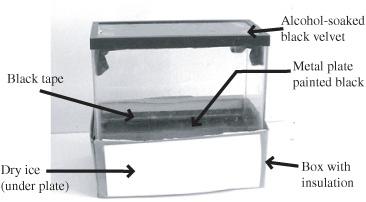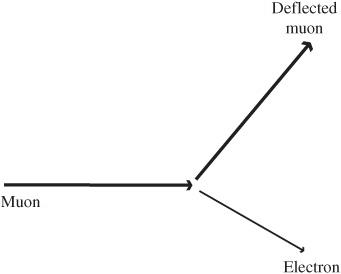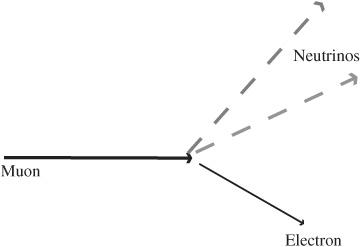125 Physics Projects for the Evil Genius (73 page)
Read 125 Physics Projects for the Evil Genius Online
Authors: Jerry Silver

Building a cloud chamber. Why muons should not be here. Special relativity
.
Cosmic rays
are subatomic particles that stream through the universe at high speed. As you read this, dozens of these particles are passing through your body harmlessly every second. In this project, you build a device called a cloud chamber, which will make some of these particles visible. The
cloud chamber
contains an alcohol vapor cloud that produces vapor trails when a charged particle passes through it. This trail reveals the path or track the particles take as they pass through the vapor cloud. You begin to learn to recognize the signature of some of those particles.
Scientists believe most cosmic rays come from the sun. These cosmic rays consist of fragments of the nuclei of hydrogen or helium atoms, resulting in particles that are either singly charged (protons) or doubly charged (alpha particles). When these cosmic ray particles strike the upper atmosphere of the Earth, they collide with the air molecules present. This results in collisions that produce new particles, called
secondary cosmic rays
. These are what you will detect in your cloud chamber.
The most common result of the collision is a particle called a
muon
. The muon is a negatively charged particle, which is bigger than an electron, but smaller than a proton. The muons that are created in the upper atmosphere decay incredibly rapidly. Because of their extremely short life, they
should not be able to survive the trip through the Earth’s atmosphere
to be detected on its surface. However, the most common particle detected in the secondary cosmic ray stream is the muon. The only way to explain the abundance of muons you see in your cloud chamber is by turning to Einstein’s theory of relativity, which says that time slows down for the very high-speed muons.
Also present in the shower of secondary cosmic rays hitting the Earth’s surface are positrons and electrons. The
positrons
are a form of antimatter that can also be seen in your cloud chamber.
- small 2.5 gallon fish tank
- small Styrofoam cooler
- 1 liter of
pure
isopropyl alcohol (
not 70 percent
alcohol, as is more readily available).
Pure
methyl alcohol can also be used. - sheet of black felt large enough to line the bottom of the tank (note, the fish tank will be turned upside down, so what we refer to as the bottom of the fish tank will become the top of the cloud chamber)
- metal plate the size of the top of the fish tank—aluminum is preferable because it conducts heat better than steel
- duct tape, silicone rubber sealant, or weather stripping to make the fish tank airtight
- black (solvent resistant) paint
- about 1 pound of dry ice to encase the bottom of the fish tank
- bright light source, such as a powerful flashlight
- strong magnet
- optional: source of low-level radiation, such as a smoke detector, mantle of old Coleman lantern, or certain old ceramic objects that contain cobalt
- optional: a digital video camera
- Because the dry ice has a limited shelf life and, for most users, takes a special effort to obtain, a good idea is to do a dry run and assemble these parts before picking up the dry ice. Also, remember dry ice is extremely cold and should not come into contact with eyes or skin.
- Attach the black felt to the bottom of the fish tank. Use black electrical tape or Velcro under the felt to secure it, so it remains in place when the fish tank is inverted. You may want to devise some other way to secure the felt such as small wooden supports. Keep in mind that whatever you use to support the felt must not be degraded by the solvent vapor that will be present. A solvent resistant glue such as Gorilla Glue or Gorilla tape can hold the felt without being attacked by the alcohol vapor.
- Place the dry ice in the bottom of the cooler. If the dry ice is in large chunks, you will have to chop it. You can add a little alcohol to the mixture to form a slush to make better thermal contact with the metal plate. If you don’t have a cooler the fish tank will fit in, use a box and line it with insulating material.
- Soak the black felt with alcohol. Avoid dripping that produces puddles of alcohol on the metal plate by not using too much alcohol.
- Cover the dry ice with the metal plate, with the side painted black facing away from the dry ice. The metal plate should be completely in contact with the dry ice. You can secure the plate to the tank first if that works better.
- Place the tank—alcohol-soaked felt up—with the metal plate over the dry ice. It is important to establish good thermal contact between the dry ice and the metal plate. People have used solid blocks of dry ice as well as crushed ice. Good thermal contact can be achieved by creating a slurry by mixing some isopropyl alcohol in with the dry ice. If you crush the dry ice, be sure to wear protective classes to avoid extremely cold dry ice fragments from contacting your eyes. The dry ice mixed with alcohol should be around −70 degrees C or −94 degrees F.
- Seal the chamber above the metal plate by wrapping electrical tape around the edge where the metal plate meets the fish tank. (Some people have found that pouring a small amount of isopropyl alcohol in the channel surrounding the metal plate helps form an airtight seal.) If air is drawn into the chamber, the vapor cloud may not from properly.
- It may be necessary to keep the top of the cloud chamber (where the alcohol-saturated felt is) from getting too cold. The bottom of the chamber should be near −60 degrees C (−76 degrees F) to enable the formation of supersaturated vapor. However, the top of the chamber should be maintained close to room temperature (22 degrees C or 72 degrees F) to promote evaporation of the alcohol. To accomplish this it may be necessary to warm the top of the chamber either with your hands or with some other means to maintain the proper temperature gradient. It might be helpful to measure the temperatures of both surfaces.
- Shine the light from the side of the tank toward the metal plate.
- The stack should look like this, from top to bottom:
– Bottom of the fish tank
– Black felt soaked with isopropyl alcohol
– Fish tank (metal plate covering the top of the tank)

Figure 125-1
Cloud chamber assembled
.
– Metal plate
– Sheets of dry ice
Observing tracks– Bottom of the Styrofoam cooler
- At first, you will notice a mist of alcohol droplets forming in the tank.
- After about 15 minutes, you should start to see the tracks of particles passing through the vapor a few centimeters above the base plate.
- It may be helpful to view the tracks by looking
toward
the light source at an angle so that the vapor trails are illuminated from
behind
. - If you have a low-level radiation source (such as one of the everyday objects mentioned in the parts list), place it near the edge of the cloud chamber and compare its effects to cosmic rays. (Smoke detectors have low-level radioactive materials, such as americium, that are packaged safety for its intended use. Do not attempt to dismantle a smoke detector to get at the radioactive isotope. The mantle for at least some Coleman gas-camper lanterns contains traces of radioactive Thorium, which can also be a safe low-level source of charged particles to view.)
- Observe what a magnet does to the tracks. Note in particular how the particle is diverted in relation to the particle’s original velocity and the north-to-south direction of the magnetic field.
- Once you get this going, a video camera can be very helpful in recording the tracks and providing an opportunity to analyze the tracks in detail. Still photography is very difficult because of the randomness of the way the tracks are created and the rapidity with which they fade. Extracting still images from a video recording is more likely to produce clear images of tracks.
After the mist forms into a supersaturated alcohol vapor, you may start to notice tracks that look like spider webs along the chamber bottom. These are cosmic rays and should be noticeable roughly several times each minute.
Alpha particles
, which are two protons and two neutrons bonded together, form sharp, well-defined tracks about 1 centimeter long.
Beta particles
, which consist of electrons, have thinner and longer tracks, roughly 3 to 10 centimeters in length.
Some of the tracks may come in straight and then sharply break in a different direction. An example of this is shown in
Figure 125-2
, which shows a muon being deflected as it dislodges an electron from an air molecule.

Figure 125-2
Collision between a muon and an atom. The muon is deflected and the electron is knocked out of the atom, leaving a second, fainter track
.
A track that starts in a straight line, but then breaks off at a sharp angle, such as shown in
Figure 125-3
, most likely is muon decay during which a muon spontaneously decays to form an electron. The electron is visible as a thinner track. The two neutrinos do not form vapor trails and are not visible because they are not charged.

Figure 125-3
Muon decay. A muon spontaneously decays into an electron and two neutrinos. The neutrinos do not leave tracks in the cloud chamber
.
You may see a very jagged, erratic path representing a low-energy particle being scattered multiple times. This is pictured in
Figure 125-4
.
If you view the chamber from the front, with the particles coming from the left, and the magnet’s north pole at the top of the chamber, particles bending toward the back of the chamber are positively charged particles (such as protons). Particles bending toward the front of the chamber are negatively charged.
Some of the radiation in cosmic rays or isotope sources consists of charged particles. As these charged particles pass through the supersaturated alcohol vapor in the chamber, the particle ionizes the molecules of the vapor. Droplets of the vapor then condense on the path left in the wake of the particle’s path, leaving a visible trail.
